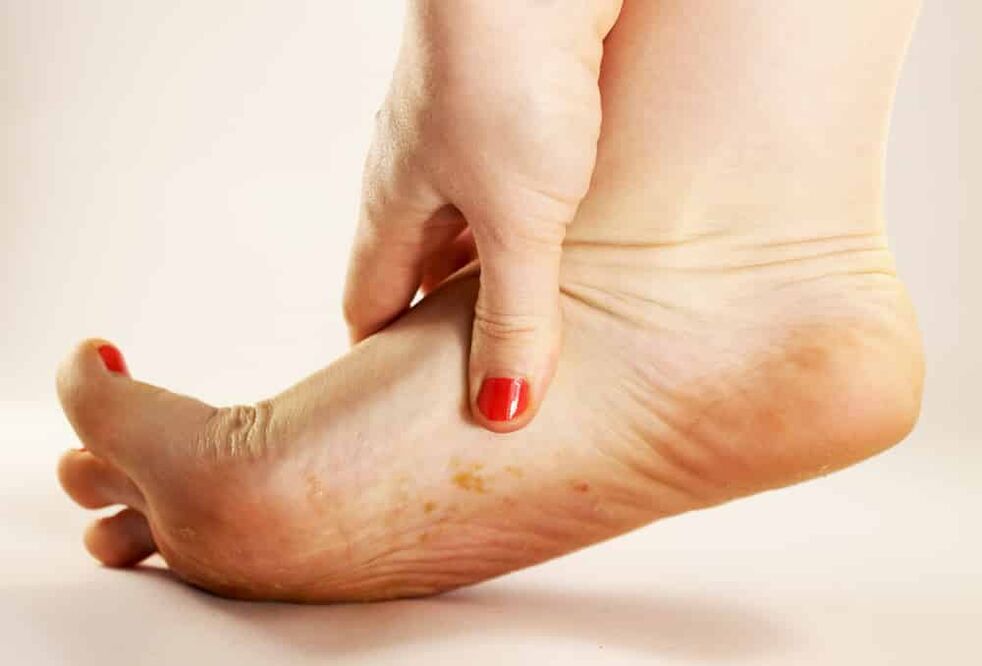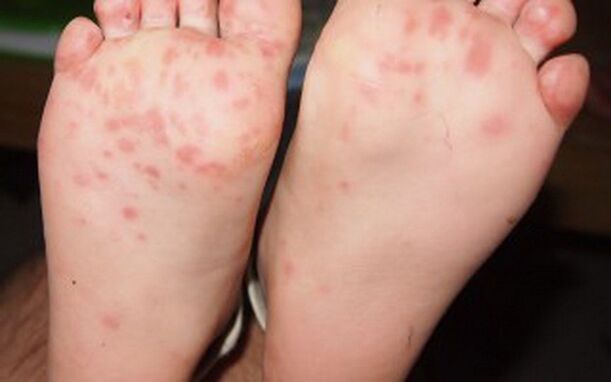"How to cure foot fungus", "how to quickly get rid of onychomycosis, foot fungus, get a young age and beat death. " These are all questions with the same degree. Fungus on the feet cannot be treated quickly and reliably, especially with home methods. You still need a dermatologist.
Foot mycosis is a skin disease caused by the spread of parasitic fungi and is one of the most common diseases affecting human skin (photo).
The disease is quite difficult to treat and leads to complications, as it rarely starts on time.

Often, a person infected with a fungal infection does not notice the symptoms and the bacteria have time to "settle" on the skin firmly.
Causes of fungus on the feet
The high prevalence of foot mycosis is explained by the fact that the disease is easily transmitted from person to person at the level of household contact.
Pathogens prefer a humid and warm environment that encourages fungal growth.
Swimming pools, gyms, baths and saunas - where one can walk barefoot on the floor, are some of the first places where you can get fungus.
The use of household items and personal belongings of a person with foot mycosis (towels, wipes) will definitely cause infection.
The second reason for the spread of fungal infections and the formation of foot mycosis is non -compliance with the rules of personal hygiene, increased sweating on the feet.
Changing sparse socks and putting them on wet feet also creates all the good conditions for fungal growth on the feet.
Symptoms of fungus on the feet
There are several forms of foot mycosis, the symptoms of which have their own special features.
Forms of deleted toe fungus
The symptoms of this form of foot mycosis are insignificant and this is an erratic skin disease.
Mild dryness and peeling of the dermis is accepted by a person as a completely normal physiological phenomenon.
Although the cracks that appear between the fingers are considered diaper rash, they are actually symptoms of fungal exposure.
Squamous-hyperkeratic foot fungus form
The most common form of foot mycosis in the population over the age of 60 is moccasin foot.
Therefore, it is mentioned because of the obvious visible signs that appear on the surface of the foot:
- thickened rough skin all over the surface;
- cracks, thickness (hyperkeratosis);
- attachment of nail plate lesions;
- the color is dirty gray, with yellowish;
- unpleasant smell;
- separation of stratum corneum, scales;
- pain while walking and inability to wear shoes.
Forms of vesicular foot fungus
Mycoses on the feet, with symptoms in the form of blister formation with a thick stratum corneum, are referred to as a form of wet fungal infection.

Bubbles that appear over time open and become like eczema, boils, psoriasis.
In general, foot mycoses manifest themselves in different ways.
The disease can start with cracked heels, the formation of broken and itchy blisters, severe diaper rash, or rough skin.
Exfoliation of the skin should not be left alone when exfoliated in large or small fragments of the feet.
There is also an unpleasant odor, the feet sweat quickly, and after being in the shoes, the feet "burn" and itch.
Complications arising from a careless attitude to the symptoms of the disease manifest themselves in the form of erosions and painful wounds on the feet, which sometimes cannot heal completely.
Foot fungus treatment
For the treatment of foot mycosis, a new generation of antimycotics is used. It is not as bad as the heart and is very effective.
However, the fungus is dangerous because it quickly develops resistance to various types of drugs, causing relapses.
To cure a fungal infection on the feet, it is necessary to make an accurate diagnosis by identifying the type of mycosis that has spread on the skin. To do this, scraping is done for the fungus.
Comprehensive treatment, with an appropriate medication intake regimen, both local and systemic, should be determined only by a specialist, as self -treatment causes the problem to worsen.
And the third point of successful healing is the patient’s strict discipline in taking medication, following a diet and taking preventative measures.
Several treatment regimens for foot mycosis are used - combination and monotherapy.
And if one drug is chosen for monotherapy, more often for external use.
The combined scheme involves several directions in treatment at once:
- external medicine;
- tablets for internal use;
- laser exposure;
- hardware pedicure.
External remedy for foot fungus
The most effective, capable of influencing fungi, are substances that destroy fungi and fungus -like fungi, able to fight dermatophytes and infections of non -fungal origin, which are often associated with foot mycosis.
This material can be presented in various forms - sprays, creams or gels, solutions, etc.
The product acts on the principle of forming a protective film, which can be retained on the skin surface for up to 72 hours.
External medication is used in the amount determined by the doctor, but most often, this procedure is performed 1-2 times a day for 2 to 4 weeks, then treatment is continued, but according to a different scheme.
Before applying the ointment or cream, the feet are cleansed.
Salicylic acid bandages are made to remove the stratum corneum, soap-soda baths, vaseline-based ointments are used to soften and remove dead tissue.
Such a procedure is carried out in a special room for medical pedicures, using a grinder.
Before treating foot mycosis with the wet type, you should dry the boils and blisters with boric acid, green or excellent iodine.
To prevent the spread of the fungus to the nail plate, a special varnish is prescribed against onychomycosis.
But this form of vesicular mycosis requires the addition of corticosteroids to the treatment regimen.
How to cure fungus on the feet - systemic therapy
Taking antimycotics inside is not indicated for all patients with foot mycosis.
The drug is quite toxic, therefore, pregnant and lactating women, small children, the elderly, as well as those with liver dysfunction are not prescribed.
According to the instructions attached to the drug or according to the scheme prescribed by the doctor, the antimycotic form of tablets is taken.
Recently, medications that relieve foot and nail fungus in 1 course have proven themselves well, relieving itching, flaking and irritation on the skin of the feet after the first use.
Folk remedies for treating fungus on the feet
If there are categorical contraindications for the treatment of foot mycosis with medications, then you can try folk remedies.
How to cure foot fungus at home:
- The acid found in grape vinegar or table vinegar (9%) is an effective folk remedy against fungi. It is used to lubricate the surface of the skin affected by mycosis and wear cotton socks over it. Leave overnight. It is not recommended to use vinegar for those who have cuts or sores on the legs. In this case, it is better to reduce the concentration of folk remedies or replace them with milder drugs.
- The brewed coffee showed good results. You need to drink the drink stronger and enough so that you can dip your feet into it. For prevention, alternative treatments are performed on two limbs at once, although mycosis is only observed on one. Perform the procedure at bedtime.
- Celandine foot bath also acts as an effective folk remedy that can get rid of foot fungus in a month. Prepare a bath at the rate of 4 tbsp. l for 1 l. air. The grass is boiled, after which the legs are soaked in a warm collection for up to half an hour. You can also use a collection of stronger ingredients for brewing - oak bark, chamomile, knotweed, sage, eucalyptus and spruce needles. All have excellent antifungal properties.
- You can also apply a lotion from a local anesthetic by soaking a cotton sponge in the medicine solution and applying it to the affected area. Folk remedies quickly relieve symptoms - pain and itching.
Prevention of fungus on the feet
Effective treatment of foot mycosis may be done with the following preventive measures:
- mandatory removal of the sole sac and the inner surface of the shoe, the more often the better. To do this, use a special antifungal spray or alcohol shoes;
- it is recommended to change the bedding every day and need to wash it at high temperatures;
- eradicating bathroom or shower surfaces, and also refusing to visit public baths during treatment;
- in public places, do not allow yourself to walk barefoot and wipe your feet dry before putting on shoes;
- it is necessary to treat the fungus at once to all family members, otherwise a person will always be infected;
- follow a diet - do not eat allergenic foods, smoked meats, preserved foods, very salty and spicy foods, sweets.
























